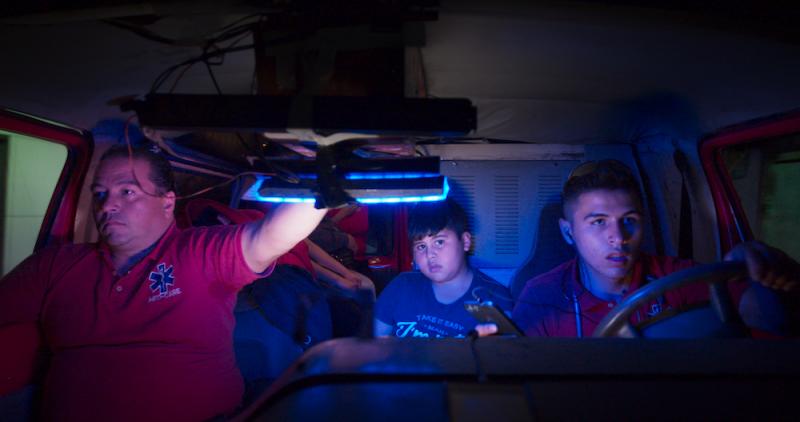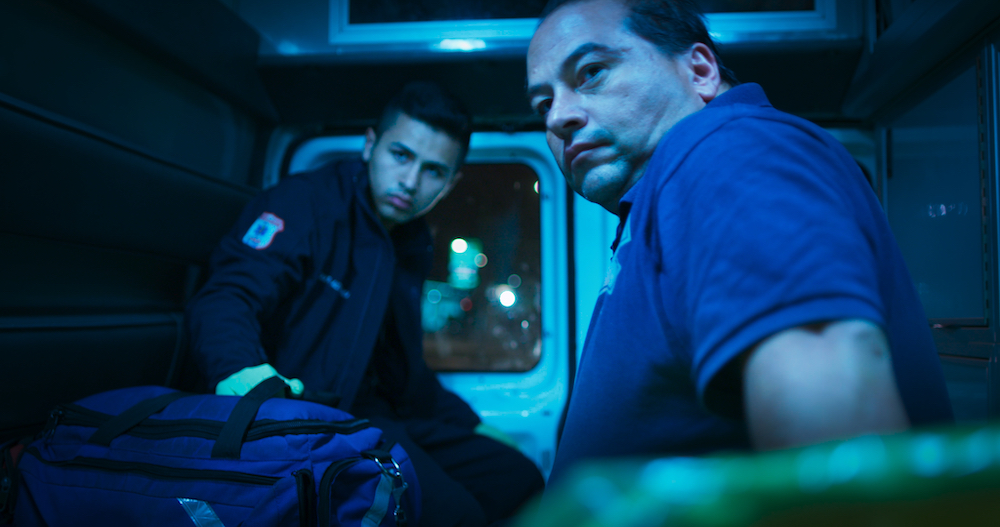Midnight Family review - a thrilling documentary set in Mexico City | reviews, news & interviews
Midnight Family review - a thrilling documentary set in Mexico City
Midnight Family review - a thrilling documentary set in Mexico City
Luke Lorentzen's intimate film tells the inside story of a family and their private ambulance service

“It’s cool to see a car crash or a gunshot wound, it’s exciting.” Emergency medical technician Juan Ochoa, 17, loves his work, which is just as well because he doesn’t always get paid.
Luke Lorentzen’s award-winning documentary (he directed, produced, shot and edited it) about the Ochoa family’s private ambulance in Mexico City is an extraordinary rollercoaster ride into the chaos of a metropolis where there are only 45 emergency ambulances for a population of 9 million. Private ambulances like the Ochoas’ take up the slack, and it’s a cutthroat business, with vehicles racing to be first at the scene of an accident. Police provide tip-offs and then have to be paid 300 pesos ($17) bribe-money per accident.
Lorentzen plunges us into the blood and guts of the city as we careen along inside the ambulance, with well groomed, energetic Juan driving like a maniac – a very skilled one – and Fer, the dad, beside him, barking instructions through a loud-speaker at anyone who gets in the way. “Move out of the way, bus, we have a critical patient. Get off the sidewalk, you idiot.” Fer, who looks exhausted and as if he could do with some medical attention himself, takes pills at regular intervals.
Also in the van is Juan’s little brother Josué, aged 10, whose sweatshirt proclaims, “It isn’t easy being cool but I manage”. It’s only at the end of the film that you see that he does, in fact, go to school. Mainly he seems to prefer ambulance life, eating makeshift meals of tuna, corn and mayo on crackers in gas stations. He sleeps in a cubby at the back, which looks about as peaceful as the Ochoas’ home, where they all sleep on the floor, religious statues take pride of place and neighbours yell into the small hours.
But it’s the roaring cacophony of the chase, as well as the sad state of the accident victims they pick up, that form the backbone of the film. A girl’s been headbutted by her boyfriend and wants a hug to calm her down before they take her to hospital – her nose may be broken. Her mother is contacted and, says Fer, she sounds fancy, which may mean she’ll pay up. But she doesn’t, and the Ochuas have to accept, yet again, that they’ve made nothing that night, though in theory they can charge 3800 pesos ($185) for transport to hospital. Another non-paying customer is a wretched man whose baby isn’t breathing (we don’t see the child, who survives). “You reek of glue,” says Juan, who’s mature beyond his years in some ways. “Your baby is not a toy. This is child abuse.”
But she doesn’t, and the Ochuas have to accept, yet again, that they’ve made nothing that night, though in theory they can charge 3800 pesos ($185) for transport to hospital. Another non-paying customer is a wretched man whose baby isn’t breathing (we don’t see the child, who survives). “You reek of glue,” says Juan, who’s mature beyond his years in some ways. “Your baby is not a toy. This is child abuse.”
It’s not always clear how the payment system functions. After one accident, we see a hospital receptionist paying out cash to the Ochoas, but Lorentzen never intervenes to make things clearer. We know that the new government administration has brought more corruption, with the cops expecting even more bribe money, and that ambulances are supposed to be no older than 2008, though hardly any are, according to Juan. He is suddenly arrested, though he’s back on the job soon with a list of items the ambulance should have on board. But can they afford to buy them? Probably not. We don’t even know if the Ochoas are medically qualified.
One of the most harrowing scenes – “We need something good tonight,” says Juan - involves picking up a woman whose daughter has a traumatic brain injury after falling four floors. She dies on the way to hospital. Her distraught mother gets in the front beside the driver and you wonder if she realises the camera is rolling. Later she, too, refuses to pay, telling the Ochoas they brought her daughter to a private hospital that was too far away from her house. We don’t know if this is true, but as the whole system is corrupt, it seems likely. And as no public ambulances are on hand, Lorentzen’s exhilarating, intimate film makes it impossible to blame the Ochoas for surviving as best they can.
The future of Arts Journalism
You can stop theartsdesk.com closing!
We urgently need financing to survive. Our fundraising drive has thus far raised £49,000 but we need to reach £100,000 or we will be forced to close. Please contribute here: https://gofund.me/c3f6033d
And if you can forward this information to anyone who might assist, we’d be grateful.

Subscribe to theartsdesk.com
Thank you for continuing to read our work on theartsdesk.com. For unlimited access to every article in its entirety, including our archive of more than 15,000 pieces, we're asking for £5 per month or £40 per year. We feel it's a very good deal, and hope you do too.
To take a subscription now simply click here.
And if you're looking for that extra gift for a friend or family member, why not treat them to a theartsdesk.com gift subscription?
more Film
 theartsdesk Q&A: director Kelly Reichardt on 'The Mastermind' and reliving the 1970s
The independent filmmaker discusses her intimate heist movie
theartsdesk Q&A: director Kelly Reichardt on 'The Mastermind' and reliving the 1970s
The independent filmmaker discusses her intimate heist movie
 Blu-ray: Wendy and Lucy
Down-and-out in rural Oregon: Kelly Reichardt's third feature packs a huge punch
Blu-ray: Wendy and Lucy
Down-and-out in rural Oregon: Kelly Reichardt's third feature packs a huge punch
 The Mastermind review - another slim but nourishing slice of Americana from Kelly Reichardt
Josh O'Connor is perfect casting as a cocky middle-class American adrift in the 1970s
The Mastermind review - another slim but nourishing slice of Americana from Kelly Reichardt
Josh O'Connor is perfect casting as a cocky middle-class American adrift in the 1970s
 Springsteen: Deliver Me From Nowhere review - the story of the Boss who isn't boss of his own head
A brooding trip on the Bruce Springsteen highway of hard knocks
Springsteen: Deliver Me From Nowhere review - the story of the Boss who isn't boss of his own head
A brooding trip on the Bruce Springsteen highway of hard knocks
 The Perfect Neighbor, Netflix review - Florida found-footage documentary is a harrowing watch
Sundance winner chronicles a death that should have been prevented
The Perfect Neighbor, Netflix review - Florida found-footage documentary is a harrowing watch
Sundance winner chronicles a death that should have been prevented
 Blu-ray: Le Quai des Brumes
Love twinkles in the gloom of Marcel Carné’s fogbound French poetic realist classic
Blu-ray: Le Quai des Brumes
Love twinkles in the gloom of Marcel Carné’s fogbound French poetic realist classic
 Frankenstein review - the Prometheus of the charnel house
Guillermo del Toro is fitfully inspired, but often lost in long-held ambitions
Frankenstein review - the Prometheus of the charnel house
Guillermo del Toro is fitfully inspired, but often lost in long-held ambitions
 London Film Festival 2025 - a Korean masterclass in black comedy and a Camus classic effectively realised
New films from Park Chan-wook, Gianfranco Rosi, François Ozon, Ildikó Enyedi and more
London Film Festival 2025 - a Korean masterclass in black comedy and a Camus classic effectively realised
New films from Park Chan-wook, Gianfranco Rosi, François Ozon, Ildikó Enyedi and more
 After the Hunt review - muddled #MeToo provocation
Julia Roberts excels despite misfiring drama
After the Hunt review - muddled #MeToo provocation
Julia Roberts excels despite misfiring drama
 London Film Festival 2025 - Bradley Cooper channels John Bishop, the Boss goes to Nebraska, and a French pandemic
... not to mention Kristen Stewart's directing debut and a punchy prison drama
London Film Festival 2025 - Bradley Cooper channels John Bishop, the Boss goes to Nebraska, and a French pandemic
... not to mention Kristen Stewart's directing debut and a punchy prison drama
 Ballad of a Small Player review - Colin Farrell's all in as a gambler down on his luck
Conclave director Edward Berger swaps the Vatican for Asia's sin city
Ballad of a Small Player review - Colin Farrell's all in as a gambler down on his luck
Conclave director Edward Berger swaps the Vatican for Asia's sin city
 London Film Festival 2025 - from paranoia in Brazil and Iran, to light relief in New York and Tuscany
'Jay Kelly' disappoints, 'It Was Just an Accident' doesn't
London Film Festival 2025 - from paranoia in Brazil and Iran, to light relief in New York and Tuscany
'Jay Kelly' disappoints, 'It Was Just an Accident' doesn't

Add comment